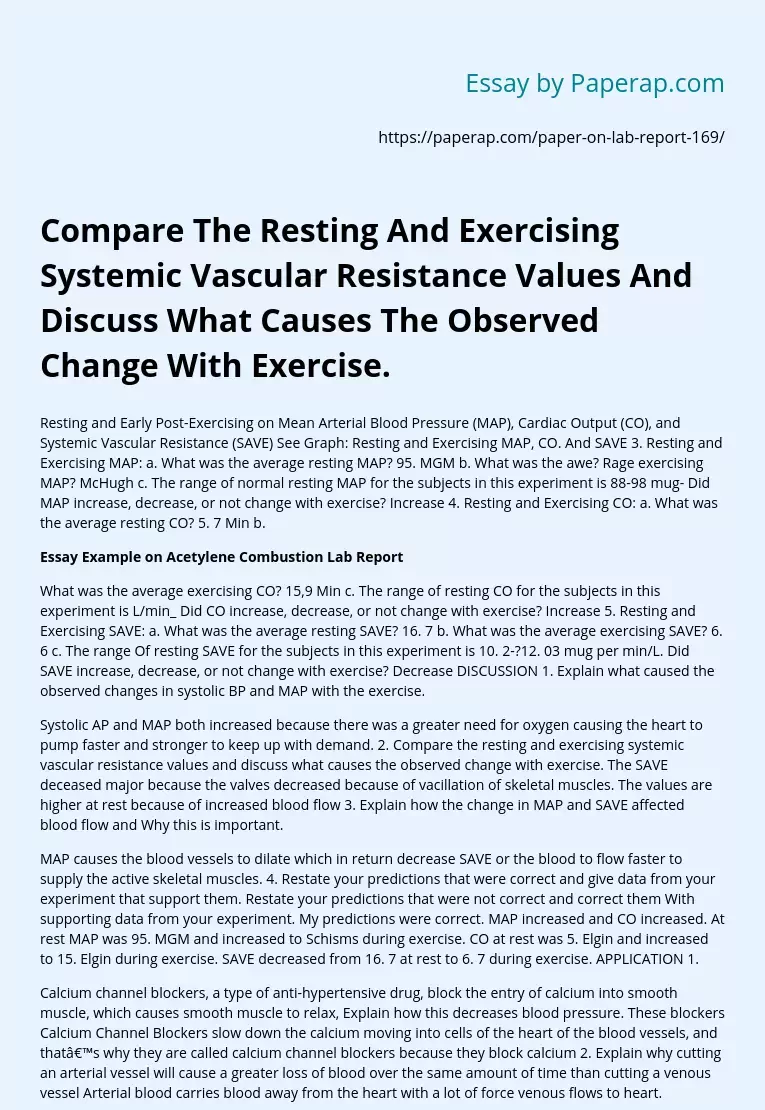Systemic Vascular Resistance: Resting vs Exercise and Causes of Change
Resting and Early Post-Exercising on Mean Arterial Blood Pressure (MAP), Cardiac Output (CO), and Systemic Vascular Resistance (SAVE) See Graph: Resting and Exercising MAP, CO. And SAVE 3. Resting and Exercising MAP: a. What was the average resting MAP? 95. MGM b. What was the awe? Rage exercising MAP? McHugh c. The range of normal resting MAP for the subjects in this experiment is 88-98 mug- Did MAP increase, decrease, or not change with exercise? Increase 4. Resting and Exercising CO: a. What was the average resting CO? 5.
7 Min b.
Essay Example on Acetylene Combustion Lab Report
What was the average exercising CO? 15,9 Min c. The range of resting CO for the subjects in this experiment is L/min_ Did CO increase, decrease, or not change with exercise? Increase 5. Resting and Exercising SAVE: a. What was the average resting SAVE? 16. 7 b. What was the average exercising SAVE? 6. 6 c. The range Of resting SAVE for the subjects in this experiment is 10. 2-?12. 03 mug per min/L.
Did SAVE increase, decrease, or not change with exercise? Decrease DISCUSSION 1. Explain what caused the observed changes in systolic BP and MAP with the exercise.
Systolic AP and MAP both increased because there was a greater need for oxygen causing the heart to pump faster and stronger to keep up with demand. 2. Compare the resting and exercising systemic vascular resistance values and discuss what causes the observed change with exercise. The SAVE deceased major because the valves decreased because of vacillation of skeletal muscles. The values are higher at rest because of increased blood flow 3.
Explain how the change in MAP and SAVE affected blood flow and Why this is important.
MAP causes the blood vessels to dilate which in return decrease SAVE or the blood to flow faster to supply the active skeletal muscles. 4. Restate your predictions that were correct and give data from your experiment that support them. Restate your predictions that were not correct and correct them With supporting data from your experiment. My predictions were correct. MAP increased and CO increased. At rest MAP was 95. MGM and increased to Schisms during exercise. CO at rest was 5. Elgin and increased to 15. Elgin during exercise. SAVE decreased from 16. 7 at rest to 6. 7 during exercise. APPLICATION 1.
Calcium channel blockers, a type of anti-hypertensive drug, block the entry of calcium into smooth muscle, which causes smooth muscle to relax, Explain how this decreases blood pressure. These blockers Calcium Channel Blockers slow down the calcium moving into cells of the heart of the blood vessels, and that’s why they are called calcium channel blockers because they block calcium 2. Explain why cutting an arterial vessel will cause a greater loss of blood over the same amount of time than cutting a venous vessel Arterial blood carries blood away from the heart with a lot of force venous flows to heart.
Systemic Vascular Resistance: Resting vs Exercise and Causes of Change. (2019, Nov 27). Retrieved from https://paperap.com/paper-on-lab-report-169/

